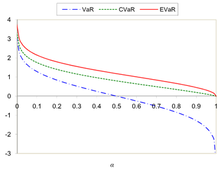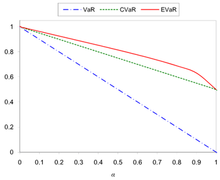In financial mathematics and stochastic optimization, the concept of risk measure is used to quantify the risk involved in a random outcome or risk position. Many risk measures have hitherto been proposed, each having certain characteristics. The entropic value at risk (EVaR) is a coherent risk measure introduced by Ahmadi-Javid,[1][2] which is an upper bound for the value at risk (VaR) and the conditional value at risk (CVaR), obtained from the Chernoff inequality. The EVaR can also be represented by using the concept of relative entropy. Because of its connection with the VaR and the relative entropy, this risk measure is called "entropic value at risk". The EVaR was developed to tackle some computational inefficiencies[clarification needed] of the CVaR. Getting inspiration from the dual representation of the EVaR, Ahmadi-Javid[1][2] developed a wide class of coherent risk measures, called . Both the CVaR and the EVaR are members of this class.
Definition[]
Let  be a probability space with
be a probability space with  a set of all simple events,
a set of all simple events,  a
a  -algebra of subsets of
-algebra of subsets of  and
and  a probability measure on
a probability measure on  . Let
. Let  be a random variable and
be a random variable and  be the set of all Borel measurable functions
be the set of all Borel measurable functions  whose moment-generating function
whose moment-generating function  exists for all
exists for all  . The entropic value at risk (EVaR) of
. The entropic value at risk (EVaR) of  with confidence level
with confidence level  is defined as follows:
is defined as follows:
-
 |
|
(1)
|
In finance, the random variable  in the above equation, is used to model the losses of a portfolio.
in the above equation, is used to model the losses of a portfolio.
Consider the Chernoff inequality
-
 |
|
(2)
|
Solving the equation  for
for  results in
results in

By considering the equation (1), we see that

which shows the relationship between the EVaR and the Chernoff inequality. It is worth noting that  is the entropic risk measure or , which is a concept used in finance and insurance, respectively.
is the entropic risk measure or , which is a concept used in finance and insurance, respectively.
Let  be the set of all Borel measurable functions
be the set of all Borel measurable functions  whose moment-generating function
whose moment-generating function  exists for all
exists for all  . The dual representation (or robust representation) of the EVaR is as follows:
. The dual representation (or robust representation) of the EVaR is as follows:
-
 |
|
(3)
|
where  and
and  is a set of probability measures on
is a set of probability measures on  with
with  . Note that
. Note that

is the relative entropy of  with respect to
with respect to  also called the Kullback–Leibler divergence. The dual representation of the EVaR discloses the reason behind its naming.
also called the Kullback–Leibler divergence. The dual representation of the EVaR discloses the reason behind its naming.
Properties[]
- The EVaR is a coherent risk measure.
- The moment-generating function
 can be represented by the EVaR: for all
can be represented by the EVaR: for all  and
and 
-
 |
|
(4)
|
- For
 ,
,  for all
for all ![{\displaystyle \alpha \in ]0,1]}](https://wikimedia.org/api/rest_v1/media/math/render/svg/d807843c397d6655a0415841bfd2d942aaa9f738) if and only if
if and only if  for all
for all  .
.
- The entropic risk measure with parameter
 can be represented by means of the EVaR: for all
can be represented by means of the EVaR: for all  and
and 
-
 |
|
(5)
|
- The EVaR with confidence level
 is the tightest possible upper bound that can be obtained from the Chernoff inequality for the VaR and the CVaR with confidence level
is the tightest possible upper bound that can be obtained from the Chernoff inequality for the VaR and the CVaR with confidence level  ;
;
-
 |
|
(6)
|
- The following inequality holds for the EVaR:
-
 |
|
(7)
|
- where
 is the expected value of
is the expected value of  and
and  is the essential supremum of
is the essential supremum of  , i.e.,
, i.e.,  . So do hold
. So do hold  and
and  .
.
Examples[]

Comparing the VaR, CVaR and EVaR for the standard normal distribution

Comparing the VaR, CVaR and EVaR for the uniform distribution over the interval (0,1)
For 
-
 |
|
(8)
|
For 
-
 |
|
(9)
|
Figures 1 and 2 show the comparing of the VaR, CVaR and EVaR for  and
and  .
.
Optimization[]
Let  be a risk measure. Consider the optimization problem
be a risk measure. Consider the optimization problem
-
 |
|
(10)
|
where  is an
is an  -dimensional real ,
-dimensional real ,  is an
is an  -dimensional real random vector with a known probability distribution and the function
-dimensional real random vector with a known probability distribution and the function  is a Borel measurable function for all values
is a Borel measurable function for all values  If
If  then the optimization problem (10) turns into:
then the optimization problem (10) turns into:
-
 |
|
(11)
|
Let  be the
be the  If
If  is convex for all
is convex for all  , then the objective function of the problem (11) is also convex. If
, then the objective function of the problem (11) is also convex. If  has the form
has the form
-
 |
|
(12)
|
and  are independent random variables in
are independent random variables in  , then (11) becomes
, then (11) becomes
-
 |
|
(13)
|
which is computationally tractable. But for this case, if one uses the CVaR in problem (10), then the resulting problem becomes as follows:
-
![{\displaystyle \min _{{\boldsymbol {w}}\in {\boldsymbol {W}},t\in \mathbb {R} }\left\lbrace t+{\frac {1}{\alpha }}{\text{E}}\left[g_{0}({\boldsymbol {w}})+\sum _{i=1}^{m}g_{i}({\boldsymbol {w}})\psi _{i}-t\right]_{+}\right\rbrace .}](https://wikimedia.org/api/rest_v1/media/math/render/svg/8fd60d85fb67797f3d44f5741f97314be2072986) |
|
(14)
|
It can be shown that by increasing the dimension of  , problem (14) is computationally intractable even for simple cases. For example, assume that
, problem (14) is computationally intractable even for simple cases. For example, assume that  are independent discrete random variables that take
are independent discrete random variables that take  distinct values. For fixed values of
distinct values. For fixed values of  and
and  the complexity of computing the objective function given in problem (13) is of order
the complexity of computing the objective function given in problem (13) is of order  while the computing time for the objective function of problem (14) is of order
while the computing time for the objective function of problem (14) is of order  . For illustration, assume that
. For illustration, assume that  and the summation of two numbers takes
and the summation of two numbers takes  seconds. For computing the objective function of problem (14) one needs about
seconds. For computing the objective function of problem (14) one needs about  years, whereas the evaluation of objective function of problem (13) takes about
years, whereas the evaluation of objective function of problem (13) takes about  seconds. This shows that formulation with the EVaR outperforms the formulation with the CVaR (see [2] for more details).
seconds. This shows that formulation with the EVaR outperforms the formulation with the CVaR (see [2] for more details).
Generalization (g-entropic risk measures)[]
Drawing inspiration from the dual representation of the EVaR given in (3), one can define a wide class of information-theoretic coherent risk measures, which are introduced in.[1][2] Let  be a convex proper function with
be a convex proper function with  and
and  be a non-negative number. The
be a non-negative number. The  -entropic risk measure with divergence level
-entropic risk measure with divergence level  is defined as
is defined as
-
 |
|
(15)
|
where  in which
in which  is the generalized relative entropy of
is the generalized relative entropy of  with respect to
with respect to  . A primal representation of the class of
. A primal representation of the class of  -entropic risk measures can be obtained as follows:
-entropic risk measures can be obtained as follows:
-
![{\displaystyle {\text{ER}}_{g,\beta }(X)=\inf _{t>0,\mu \in \mathbb {R} }\left\lbrace t\left[\mu +{\text{E}}_{P}\left(g^{*}\left({\frac {X}{t}}-\mu +\beta \right)\right)\right]\right\rbrace }](https://wikimedia.org/api/rest_v1/media/math/render/svg/03980f4d09c2a5a913ca0a64866c3a747d851fd5) |
|
(16)
|
where  is the conjugate of
is the conjugate of  . By considering
. By considering
-
 |
|
(17)
|
with  and
and  , the EVaR formula can be deduced. The CVaR is also a
, the EVaR formula can be deduced. The CVaR is also a  -entropic risk measure, which can be obtained from (16) by setting
-entropic risk measure, which can be obtained from (16) by setting
-
 |
|
(18)
|
with  and
and  (see [1][3] for more details).
(see [1][3] for more details).
For more results on  -entropic risk measures see.[4]
-entropic risk measures see.[4]
Disciplined Convex Programming Framework[]
The disciplined convex programming framework of sample EVaR was proposed by Cajas[5] and has the following form:
-
 |
|
(19)
|
where  ,
,  and
and  are variables;
are variables;  is an exponential cone;[6] and
is an exponential cone;[6] and  is the number of observations. If we define
is the number of observations. If we define  as the vector of weights for
as the vector of weights for  assets,
assets,  the matrix of returns and
the matrix of returns and  the mean vector of assets, we can posed the minimization of the expected EVaR given a level of expected portfolio return
the mean vector of assets, we can posed the minimization of the expected EVaR given a level of expected portfolio return  as follows.
as follows.
-
 |
|
(20)
|
Applying the disciplined convex programming framework of EVaR to uncompounded cumulative returns distribution, Cajas[5] proposed the entropic drawdown at risk(EDaR) optimization problem. We can posed the minimization of the expected EDaR given a level of expected return  as follows:
as follows:
-
 |
|
(21)
|
where  is a variable that represent the uncompounded cumulative returns of portfolio and
is a variable that represent the uncompounded cumulative returns of portfolio and  is the matrix of uncompounded cumulative returns of assets.
is the matrix of uncompounded cumulative returns of assets.
For other problems like risk parity, maximization of return/risk ratio or constraints on maximum risk levels for EVaR and EDaR, you can see [5] for more details.
The advantage of model EVaR and EDaR using a disciplined convex programming framework, is that we can use softwares like CVXPY [7] or MOSEK[8] to model this portfolio optimization problems. EVaR and EDaR are implemented in the python package Riskfolio-Lib.[9]
See also[]
References[]




































![{\displaystyle \alpha \in ]0,1]}](https://wikimedia.org/api/rest_v1/media/math/render/svg/d807843c397d6655a0415841bfd2d942aaa9f738)




































![{\displaystyle \min _{{\boldsymbol {w}}\in {\boldsymbol {W}},t\in \mathbb {R} }\left\lbrace t+{\frac {1}{\alpha }}{\text{E}}\left[g_{0}({\boldsymbol {w}})+\sum _{i=1}^{m}g_{i}({\boldsymbol {w}})\psi _{i}-t\right]_{+}\right\rbrace .}](https://wikimedia.org/api/rest_v1/media/math/render/svg/8fd60d85fb67797f3d44f5741f97314be2072986)
















![{\displaystyle {\text{ER}}_{g,\beta }(X)=\inf _{t>0,\mu \in \mathbb {R} }\left\lbrace t\left[\mu +{\text{E}}_{P}\left(g^{*}\left({\frac {X}{t}}-\mu +\beta \right)\right)\right]\right\rbrace }](https://wikimedia.org/api/rest_v1/media/math/render/svg/03980f4d09c2a5a913ca0a64866c3a747d851fd5)




















